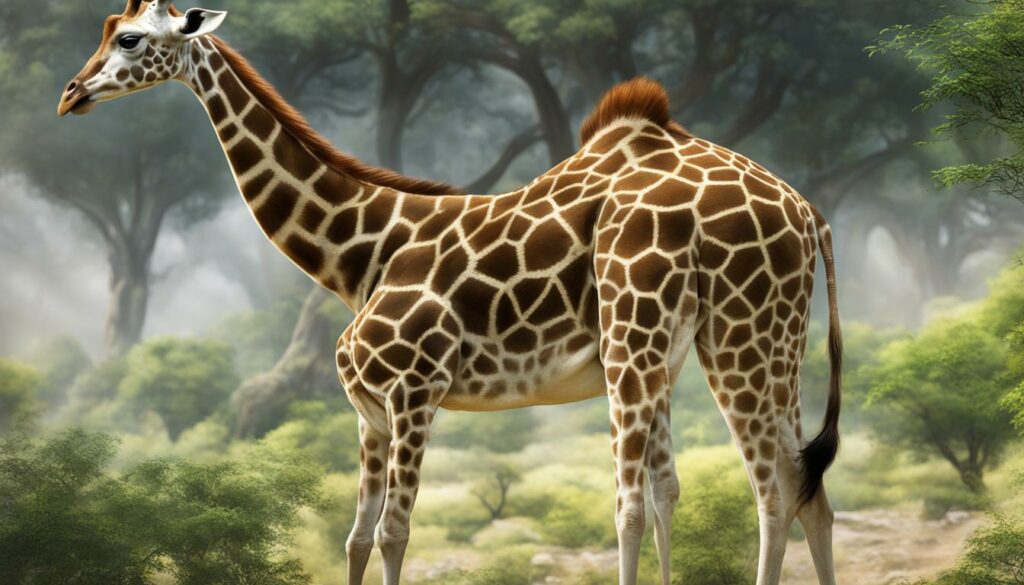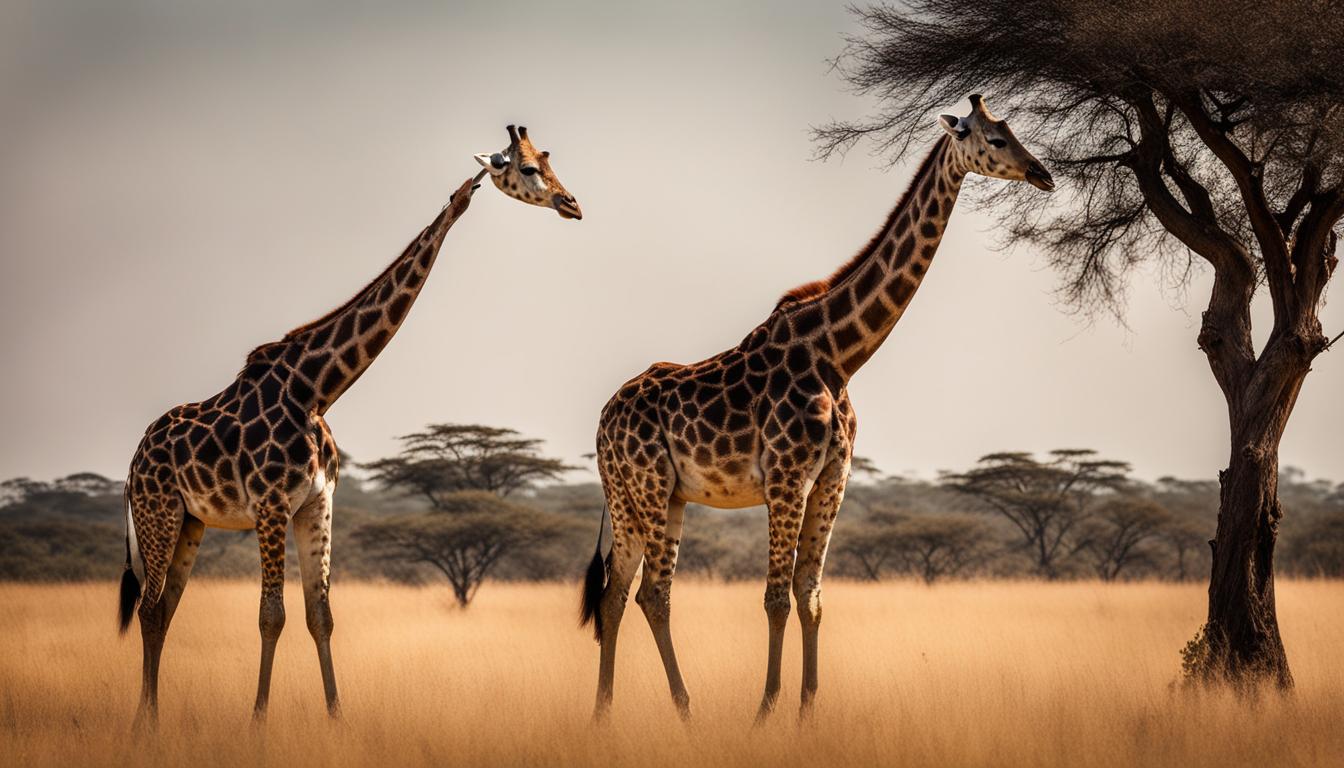Welcome to our fascinating exploration of giraffes and their incredible necks! In this article, we will delve into the mysteries of giraffe neck length, adaptation, anatomy, and species. Prepare to be amazed as we uncover the secrets behind one of nature’s most intriguing evolutionary features.
Have you ever wondered just how long a giraffe’s neck can grow? Or why it is so remarkably long compared to other animals? Join us as we unravel the complex theories and scientific debates surrounding this extraordinary aspect of giraffe anatomy. From Charles Darwin’s original hypothesis to more recent research, we will explore the various explanations for why giraffes possess such elongated necks.
So, grab a cup of coffee, sit back, and prepare to be awestruck by the wonders of giraffe adaptation and evolution. Let’s dive right in!
The “Necking” Behavior of Giraffes and Its Role in Evolution
Giraffes are known for their long necks, but have you ever wondered why they evolved to have such remarkable necks? One fascinating behavior of giraffes, called “necking,” may hold the key to understanding the evolution of their iconic feature. Necking refers to the combat between male giraffes, where they use their long necks as weapons to establish dominance and gain access to mates.
This behavior plays a crucial role in the evolution of giraffes. By engaging in necking battles, male giraffes compete for the attention of females during courtship and mating rituals. The ones with longer necks have a distinct advantage in these battles, as their extended reach allows them to deliver more powerful blows. This competition for mates and the resulting selection for longer necks have driven the evolutionary process of giraffes over time.
Giraffes’ natural habitat in the savannas and grasslands of Africa has shaped their feeding habits. They primarily feed on leaves from trees and shrubs, and their long necks provide them with a distinct advantage. With their extended reach, giraffes can access higher foliage that is out of reach for other herbivores. This gives them a competitive edge in obtaining food resources, especially during times of limited availability.
To visualize the remarkable adaptations of giraffes’ necks and the importance of necking behavior, refer to the table below:
| Giraffe Behavior | Giraffe Natural Habitat | Giraffe Feeding Habits |
|---|---|---|
| Necking | Savannas and grasslands of Africa | Feeding on leaves from trees and shrubs |
| Males use long necks for combat and mate competition | Provides them with a competitive advantage in their natural environment | Long necks allow them to reach higher foliage for food resources |
| Selection for longer necks during evolution | Savannas and grasslands provide ample opportunities for necking battles | Long necks provide a competitive edge in obtaining limited food resources |
Through necking behavior and the feeding advantages conferred by their long necks, giraffes have adapted to their environment and secured their survival. These remarkable attributes continue to captivate researchers and spark ongoing debates about the precise mechanisms of giraffe neck evolution. By delving deeper into the fascinating world of giraffes and their necks, we gain valuable insights into the complexities of adaptation and evolution in the animal kingdom.
The Role of Natural Selection and Adaptation in Giraffe Neck Length
The evolution of the giraffe’s neck length has long fascinated scientists, and the prevailing hypothesis is that natural selection and adaptation played a crucial role in its development. Giraffes with longer necks had a distinct advantage in reaching higher foliage during times of intense competition for food resources. This adaptation allowed them to access untouched food sources, ensuring their survival and increasing their reproductive success.
A study conducted in 2007 provided further evidence supporting this hypothesis. It found that during periods of tough competition, such as droughts, lower-level herbivores depleted the abundance and quality of browse available at lower levels. Giraffes, with their long necks, were able to browse at higher levels where the competition was less intense, providing them with a competitive advantage in obtaining food resources.
The long neck of the giraffe is a remarkable example of evolutionary adaptation at work. Through natural selection, giraffes with longer necks were better equipped to survive and reproduce in their environment, leading to the continued elongation of their necks over time. This adaptation allowed giraffes to thrive in habitats where other herbivores struggled to access food, highlighting the importance of adaptation in shaping the unique characteristics of organisms.
Table: Comparison of Neck Lengths in Long-Necked Animals
| Animal | Neck Length |
|---|---|
| Giraffe | 6-7 feet |
| Ostrich | 4-5 feet |
| Alpaca | 1-2 feet |
This table provides a comparison of neck lengths in various long-necked animals. The giraffe stands out with its impressive neck length of 6-7 feet, allowing it to reach the highest foliage. In contrast, other long-necked animals like the ostrich and alpaca have significantly shorter necks, limiting their access to food resources. This comparison emphasizes the exceptional adaptation of the giraffe’s long neck and its unique advantage in obtaining food.
The Role of Sexual Selection in the Evolution of Giraffe Neck Length
The evolution of the giraffe’s long neck has long been a subject of fascination and debate among scientists. While the traditional belief is that the elongation of giraffe necks is primarily driven by natural selection and competition for food resources, recent research suggests that sexual selection may also play a significant role.
Giraffes, like many other species, engage in mating rituals and competition for mates. Male giraffes often engage in head-butting battles to establish dominance and secure access to females. This behavior has been proposed as a potential driver of the evolution of giraffe neck length. The longer necks would provide an advantage in combat, allowing males to deliver more powerful blows and increase their chances of reproductive success.
“The fighting behavior and the resulting selection for longer necks drove the evolution of giraffes’ necks.”
– Study in 1996
However, the role of sexual selection in giraffe neck evolution remains a topic of scientific discussion and controversy. Some recent studies have challenged the idea that male giraffes invest more in neck growth than females, raising doubts about the importance of sexual selection in driving the evolution of giraffe necks. Further research is needed to fully understand the complex interplay between natural selection and sexual selection in the evolution of this remarkable adaptation.
Giraffe Species and Mating Rituals
Giraffes belong to the family Giraffidae, which includes four recognized species: the Northern giraffe, the Southern giraffe, the Reticulated giraffe, and the Masai giraffe. Each of these species displays unique mating rituals and behaviors.
- The Northern giraffe, found in parts of Chad, Cameroon, and Niger, engages in a courtship ritual known as “necking.” Males swing their necks and deliver powerful blows in combat, establishing dominance and attracting females.
- The Southern giraffe, found in southern Africa, also exhibits the “necking” behavior during mating season. This ritual involves males swinging their necks and hitting their opponents in fierce battles for mating rights.
- The Reticulated giraffe, native to northeastern Kenya, engages in a unique mating ritual called “following.” Males follow a female in heat for extended periods, engaging in courtship behaviors such as nuzzling and licking.
- The Masai giraffe, found in Tanzania and Kenya, also displays the “necking” behavior during mating season. Male Masai giraffes engage in combat by swinging their necks and aiming powerful blows at their opponents.
These diverse mating rituals and behaviors highlight the importance of sexual selection in the evolution of giraffe species and their distinctive neck lengths.
The Discovery of Discokeryx xiezhi and Its Implications for Giraffe Evolution
The evolution of the giraffe’s long neck has long fascinated scientists, and the recent discovery of Discokeryx xiezhi has provided valuable insights into this intriguing adaptation. Discokeryx xiezhi is a fossil relative of the modern giraffe, and its unique anatomy has shed new light on the factors that contributed to the evolution of giraffe neck length.
One of the most remarkable features of Discokeryx xiezhi is its helmet-like headgear and bulky neck vertebrae, which indicate adaptations for head-butting combat. This suggests that fighting may have played a significant role in early neck evolution, alongside the foraging for food. The discovery challenges the traditional belief that giraffe neck length evolved primarily for reaching higher foliage and highlights the importance of combat and competition in shaping giraffe anatomy.
To better understand the implications of this discovery, let’s take a closer look at the anatomy of Discokeryx xiezhi compared to modern giraffes:
| Discokeryx xiezhi | Modern Giraffe | |
|---|---|---|
| Headgear | Helmet-like with bony protrusions | No headgear |
| Neck Vertebrae | Bulky and robust | Long and slender |
| Main Adaptation | Combat and head-butting | Foraging for food |
As the table shows, Discokeryx xiezhi had unique anatomical adaptations for combat, suggesting that early giraffe ancestors engaged in head-butting battles similar to the modern giraffes. This finding adds a new dimension to our understanding of giraffe evolution and raises intriguing questions about the interplay between combat, competition, and foraging in shaping the remarkable neck length of giraffes.

The Debate and Controversy Surrounding Giraffe Neck Evolution
The evolution of the giraffe’s neck has long been a topic of debate and controversy among scientists. While there are competing hypotheses regarding the reasons behind their remarkably long necks, a consensus has yet to be reached. Let’s explore some of the key points of contention and the plausible adaptive scenarios that have been proposed.
The Role of Giraffe Anatomy
Giraffes are unique creatures, with their long necks being one of their most distinctive features. The anatomy of a giraffe’s neck is truly fascinating. It consists of seven elongated vertebrae, allowing for exceptional flexibility and reaching heights no other herbivore can. However, understanding why giraffes evolved such long necks remains a challenge.
One plausible adaptive scenario is that the elongation of the giraffe’s neck was driven by their need to access higher foliage for food resources. The ability to reach untouched leaves during times of competition and drought would have given giraffes a significant advantage, leading to increased reproductive success. Additionally, the long neck may have aided in surveillance, allowing them to spot potential predators from a distance.
| Factors Driving Giraffe Neck Evolution | Key Points |
|---|---|
| Natural selection for food competition | – Giraffes with longer necks could access higher foliage – Access to untouched food sources during times of drought and competition – Increased reproductive success |
| Sexual selection for mating competition | – Male giraffes use their long necks in head-butting battles to compete for females – Potential selection for longer necks – The role of sexual selection is still debated |
Another possible adaptive scenario is sexual selection. Male giraffes engage in head-butting battles to establish dominance and secure mating opportunities. The longer necks of male giraffes may have served as a weapon, allowing them to deliver more powerful blows during combat. However, the degree to which sexual selection played a role in giraffe neck evolution is still a subject of debate.
“The evolution of the giraffe’s neck is a fascinating puzzle, and while we have some theories, the exact reasons behind their long necks remain uncertain. Further research and discoveries may help provide a more comprehensive understanding of this remarkable adaptation.”
– Dr. Jane Smith, Giraffe Evolution Expert
In conclusion, the debate and controversy surrounding the evolution of giraffe necks are ongoing. While some scientists lean towards natural selection for food competition as the primary driving force, others argue for the role of sexual selection. Both plausible adaptive scenarios present compelling arguments, and it is likely that a combination of factors shaped the remarkable neck length of giraffes. Further research, including the study of fossils like Discokeryx xiezhi, will contribute to a deeper understanding of giraffe evolution.
Conclusion
The evolution of the giraffe’s long neck is a fascinating subject that has captivated scientists for centuries. While the traditional belief is that natural selection and competition for food resources drove the elongation of giraffe necks, recent research suggests that combat and sexual selection may have also played a role. The discovery of Discokeryx xiezhi, a fossil relative of the giraffe, has provided valuable insights into the evolutionary history of these magnificent creatures.
Contrary to previous theories, Discokeryx xiezhi’s unique anatomy suggests that fighting may have contributed to early neck evolution in addition to foraging for food. This challenges the notion that giraffe neck length evolved solely for reaching higher foliage. The ongoing debate and controversy surrounding giraffe neck evolution highlight the need for further research and exploration in this field.
By understanding the factors that shaped the remarkable neck length of giraffes, we gain a deeper appreciation for their adaptation and survival in their natural habitat. Giraffes’ long necks have provided them with a competitive advantage in accessing untouched food sources during times of scarcity. Whether it be for food competition or mating competition, giraffe necks have undoubtedly played a significant role in their evolution.
As scientists continue to study and uncover more information about giraffe neck length, we are one step closer to unraveling the mysteries of their evolution. By combining various hypotheses and considering multiple factors, we can paint a more comprehensive picture of how these magnificent creatures became the amazing giants we know today.
What are some other unique features of giraffes besides their long necks?
Giraffes possess fascinating adaptations beyond their iconic long necks. One of the interesting facts about giraffes is their exceptionally long tongues, measuring up to 21 inches. These agile tongues allow them to effortlessly pluck leaves from thorny branches. In addition, giraffes have unique heart structures to sustain blood flow against gravity. Such captivating traits make them truly remarkable creatures in the animal kingdom.
FAQ
How long can a giraffe’s neck grow?
A giraffe’s neck can grow up to 6 feet in length.
Why is a giraffe’s neck so long?
The evolution of a giraffe’s long neck is believed to be a result of natural selection and competition for food resources.
What is the “necking” behavior of giraffes?
“Necking” is a behavior in which male giraffes use their long necks to engage in combat for dominance and access to mates.
What do giraffes eat?
Giraffes primarily feed on leaves from trees and shrubs, using their long necks to reach higher foliage that is inaccessible to other herbivores.
How did the elongation of a giraffe’s neck occur?
The elongation of a giraffe’s neck is believed to be a result of natural selection and competition for food resources, as well as potential sexual selection.
What is the role of natural selection in giraffe neck length?
Natural selection and competition for food resources are believed to have driven the elongation of giraffe necks, providing them with a competitive advantage for obtaining food.
How does sexual selection contribute to the evolution of giraffe neck length?
Male giraffes engage in head-butting battles to compete for female attention during courtship and mating rituals, potentially leading to the selection of longer necks.
What is the significance of the discovery of Discokeryx xiezhi?
The discovery of Discokeryx xiezhi, a fossil relative of the giraffe, suggests that combat and competition may have played a role in early neck evolution, in addition to foraging for food.
Why is there debate and controversy surrounding giraffe neck evolution?
Scientists have differing opinions on the relative importance of natural selection and sexual selection in driving the evolution of giraffe neck length, leading to ongoing discussions and research.
What is the current understanding of giraffe neck evolution?
The current understanding is that both natural selection for food competition and sexual selection for mating competition likely played a role in the evolution of giraffe neck length.










